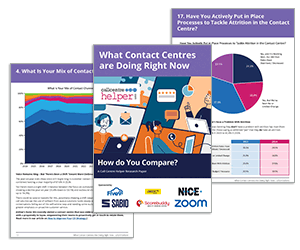Call avoidance is a common challenge in contact centres, impacting both customer satisfaction and loyalty. Left unaddressed, it can lead to longer wait times, frustrated customers, and reduced efficiency.
In this article, we explore what call avoidance is, why it occurs, and actionable strategies to help contact centres address and prevent it effectively.
What Is Call Avoidance in a Call Centre?
Call avoidance refers to strategies or behaviours that contact centre agents use to reduce the number of customer interactions they handle.
Why Does It Happen?
Call avoidance often arises from various factors such as workplace stress, lack of training, poor systems or tools, or unrealistic performance targets.
High-pressure environments may push agents toward avoidance tactics, especially if they feel overwhelmed or unsupported.
Insufficient training can leave agents unsure of how to manage certain enquiries, making avoidance seem like the easier option. Outdated or inefficient systems can frustrate agents, slowing them down and encouraging delays.
Additionally, when contact centres enforce overly aggressive performance metrics, some agents may resort to avoidance behaviours to meet expectations or protect themselves from burnout.
How Does Call Avoidance Occur?
Call avoidance can manifest in several ways, including:
- Extended After-Call Work (ACW): Agents may spend excessive time on post-call administrative tasks to delay the next call.
- Frequent Breaks: Repeated or prolonged breaks reduce availability for incoming calls.
- System Manipulation: This includes intentionally staying in “not ready” status or logging out of systems.
- Transfer Abuses: Agents may pass customers to other departments to avoid handling complex queries.
- Silent Calls or Call Drops: In rare cases, agents may intentionally disconnect or remain silent during a call to prompt the customer to hang up.
7 Strategies to Prevent Agents From Avoiding Calls
Dealing with call avoidance requires a combination of proactive management, improved processes, and a supportive work environment.
By understanding the root causes and implementing targeted solutions, call centres can reduce avoidance behaviours and improve overall performance.
1. Identify the Root Cause
The first step is to investigate why call avoidance is occurring. Analyse performance data, listen to call recordings, and gather feedback from agents to uncover common patterns.
Identifying whether avoidance stems from stress, inadequate training, or system inefficiencies will help you apply the right solution.
2. Improve Training and Development
Lack of knowledge or confidence can drive agents to avoid challenging calls. Investing in comprehensive training programmes ensures agents feel equipped to handle complex queries.
Regular coaching sessions can boost their skills and reinforce best practices, reducing the need for avoidance tactics.
3. Enhance Systems and Tools
Outdated or inefficient software can frustrate agents and slow their response times. Investing in user-friendly, integrated systems can streamline workflows and improve productivity.
Providing quick-access knowledge bases or AI-driven support tools can also empower agents to resolve issues efficiently.
4. Set Realistic Performance Metrics
Unrealistic targets can push agents toward avoidance as a coping mechanism. While performance goals are essential, they should be achievable and balanced with quality assurance measures.
Focusing on customer satisfaction alongside metrics like average handling time (AHT) can encourage agents to prioritize effective resolutions rather than rushing calls.
5. Create a Supportive Work Environment
A positive workplace culture plays a significant role in reducing call avoidance. Encourage open communication where agents feel comfortable discussing their challenges.
Recognizing achievements, offering mental health support, and promoting a healthy work–life balance can improve morale and reduce stress-related avoidance behaviours.
6. Monitor and Provide Feedback
Consistent monitoring helps identify agents who may be struggling with avoidance behaviours. Instead of penalizing them immediately, provide constructive feedback and guidance.
Personalized coaching plans can help agents develop better coping strategies and improve their overall performance.
7. Promote Team Engagement and Motivation
Keeping agents engaged through team-building activities, incentives, and career growth opportunities can increase job satisfaction and reduce the temptation to avoid calls. Motivated employees are more likely to stay committed to their roles and deliver better customer service.
By combining these strategies, contact centres can create an environment where agents feel supported, empowered, and motivated to deliver exceptional customer experiences without resorting to avoidance tactics.
How to Avoid Calls Without Losing Customers
Avoiding calls strategically while maintaining customer satisfaction requires the use of alternative communication channels and improved self-service options.
Implementing AI chatbots, knowledge bases, and comprehensive FAQs can provide customers with immediate answers to common questions. Proactive communication, such as automated updates via email or SMS, can also reduce the need for inbound calls by keeping customers informed.
Investing in digital tools that facilitate efficient self-service and proactive outreach enables contact centres to reduce call volumes while preserving customer loyalty.
By combining these strategies, contact centres can help reduce the need for calls about common questions such as contact centre opening hours and therefore reduce call volumes.
This article is a revised version of Complete Guide on Call Avoidance in Call Centres, originally published by Scorebuddy.
For more on tackling call avoidance in your contact centre, read these articles next:
- 20 Sneaky Tricks That Call Centre Agents Use to Avoid Calls
- Employee Well-Being: How to Reduce Contact Centre Stress
- Mastering IVR – What to Do and Avoid
Author: Hannah Swankie
Reviewed by: Megan Jones
Published On: 16th Apr 2025
Read more about - Expert Insights, Call Handling, Scorebuddy
















